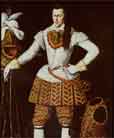 |
Das Geheimnis um Shakespeares ‘Dark Lady’
[The secret around Shakespeare’s ‘Dark Lady’]
f. Leserbriefe / Letters to the Editor |
Leserbrief der Autorin an den Daily Telegraph (London) auf Wunsch von David Tristram Davies, Letters Editor (2. Oktober
1999):
Meet Shakespeare’s Dark Lady ...
„SIR - A. L. Rowse was right in identifying the
Earl of Southampton as Shakespeare’s young friend and patron in
the sonnets (article, Sept. 21) but wrong in saying that the Dark Lady
was Emilia Lanier Bassano.
Early in 1997, I came to realise that M a r c u s G h e e r a e r t s
’ s The Persian Lady, which was painted between 1590 and
1600 and is at Hampton Court Palace, contains decisive evidence about
the Dark Lady. The picture shows an unknown, heavily pregnant lady of
high rank who is festively dressed.
In the upper lefthand corner, a Latin inscription proclaims that‘As
the just complaint of the unjust even the pain of the rod is as medicine
to me’, and in the lower righthand corner there is an outstanding
and hitherto unidentified sonnet which complains that ‘others’
have taken away the fruit of the author’s love.
With the help of experts in linguistics, medicine, botany and criminology,
I have identified its author as Shakespeare and the elegant enceinte stranger as Elizabeth Vernon, who married Southampton in late August 1598.
A senior gynaecologist states that, in his opinion, the pregnant woman
in the painting is about eight to 12 weeks before childbirth. Vernon’s
daughter Penelope was born on Nov. 8, 1598 - about 10 weeks later.
In a later portrait showing the countess at her toilet at Boughton House,
Northants, I discovered a hitherto unnoticed hint. Vernon is p o i n t
i n g t o S h a k e s p e a r e ’ s f a c e, which is stitched on
her right sleeve. Since 16th century painitings are generally serious
historical sources, this is a c l e a r m e s s a g e t o p o s t e r
i t y. Love’s Labour’s Lost contains the lines, ‘This
gallant pins the wenches on his sleeve;/ Had he been Adam, he had tempted
Eve’.
In 1615, Penelope, Vernon’s beautiful first born daughter whom her
contemporaries regarded as the embodiment of all femaled virtues, married
Lord Spencer. A German CID scientist has confirmed from examining Van
Dyk’s portrait of her that there is striking resemblance to Shakespeare
but none whatsoever to Southampton.
My book T h e S e c r e t o f S h a k e s p e a r e ’ s ‘D
a r k L a d y’: Revelations Based on Documentary Evidence has r e c e n t l y b e e n p u b l i s h e d in Darmstadt.
It is interesting to note that Rowse emphasised in 1964 the sonnet’s
autobiographical character, remarking: ‘How modern, how recognisable
it all is!’
Prof Hildegard Hammerschmidt-Hummel Mainz University, Germany“
|
Seitenanfang / top of the page |








 |









